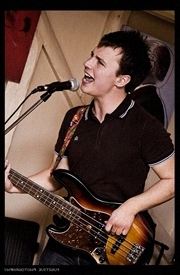Tutor HuntResources Bass Guitar Resources
Technology Within The Electric Bass Guitar
A condensed look at the history of the bass guitar and how technology has affect it.
Date : 11/03/2013
Author Information

Uploaded by : Nik
Uploaded on : 11/03/2013
Subject : Bass Guitar
The first patented electric bass guitar was created by Clarence Leo Fender of the Fender Electric Instrument Company Los Angeles in 1951 and was dubbed the Fender Precision Bass due to its precise and adjustable intonation on the neck compared to a double bass. However, Fender were not the first company to try and create an electric bass; pre 1951, companies such as Ampeg, Gibson, Rickenbacker and Vega all made admirable attempts to synthesise an amplified bass guitar but all failed, due to poor practicality and bad amplification.
None of these efforts were commercially successful and none of them were helped by the poor quality of amplification available at the time. Makers seemed to know that bass players wanted a louder instrument but had trouble finding a suitable way of helping them. (Bacon and Moorhouse, 2008, p7.)
The creation of the electric bass guitar gave musicians the chance to play a bass instrument that was audible, easily portable and affordable. These factors were what drove many double bass players to abandon their instruments and convert to the electric bass guitar.
Leo's 1951 Fender Precision Bass took the 'doghouse bass viol' and made it heard with a great pickup, made it portable without a furniture van and made it easier for a guitarist to play 'in tune'. (Balmer. 2010, p6)
The fact that it could be amplified and heard within a band environment gave the instrument appeal amongst double bass players. Amplifiers were becoming an essential piece of equipment: Fender provided the Fender Bassman amplifier in 1951 and Gibson's answer was the six speaker GA-90 a year later. Monk Montgomery from the Lionel Hampton Band was the first notable bass guitarist who came from a double bass background. Although at first he was not keen to change to the electric bass guitar, he later preferred the new instrument, and stated in December 1957 that "(Hampton) could hear the bass, really hear it as much as you feel it. When there is an upright in the band, you don't really hear it as much as you feel it" (cited in Bacon and Moorhouse. 2008, p17).
When watching a live band, some people in the audience can hear the bass faintly if a low wattage amp is used, but when a high wattage amp is used people can really feel the sound. Since the creation of the first high watt amplifiers from Acoustic and Ampeg the bass guitar has been a large part in the overall sound of a live band, giving the audience the melodic support which the guitars and vocals stand on. Amplifiers play a big part in how the electric bass should be heard; with gain and EQ settings players can sculpt their tone to suit the music and even keep the sound under control with built in compressors
Technique and technology have always been the driving aspects to the progression of any instrument in the history of music. When looking at the electric bass guitar, the thing to remember is that it is an instrument that was marketed for double bass players and guitarists; and it was essentially aiding both parties. It gave double bassists a practical answer to problems such as portability and audibility and it presented a friendlier transition for a guitarist looking at a bass instrument that did not require a drastic change in technique. It could be argued that the bass guitar was a technological innovation that was presented as an 'upgrade' to the double bass. However, the double bass still has its use amongst specific genres and styles of music, as does the electric bass guitar.
Clarence Leo Fender's 1951 Precision Bass set the standard for what a good bass should look and sound like. Although adjustments have been made to the bass it hasn't actually changed much since it was first developed, a statement which stands true for the Fender Jazz Bass also. It is interesting that despite all the advances that other bass guitar makes have seen, such as active electronics, hip shot tuners, graphite necks, additional strings and so on, both the Fender Precision and the Fender Jazz Bass basses in their basic form remain the most popular basses in the world; it is odd to see that a company got the designs right the first time around. However, with regards to amplifiers, the creation of models such as the Acoustic 360 and the Ampeg SVT 300 marked the beginning of high wattage amplifiers which were loud enough for any venue. Since their creation the standards keep getting higher with aspects such as equalisation to customise the tones and compression which balances out the overall sound of the notes played; the amplifiers can hit high noise levels with a sustained tonal centre. Perhaps the final words should go to my old mentor Akos Hasznos who states that "If you`ve got a good tone you can get away with less technique or it will make it more obvious if you got good technique" which suggests that the standard of bass players has increased apace with the advances in amplification.
Reference List
Bacon, T. and Moorhouse, B. (2008) The Bass Book, 2nd edn. New York: Backbeat books
Balmer, P. (2010) Fender Bass Manual, 1st edn. Somerset: Haynes Publications
Goelz, R. (2003) History Of The Electric Bass Guitar. Online. Available from: www.rodgoelz.com/electricbasshistory.htm [Accessed 19.3.11]
This resource was uploaded by: Nik
